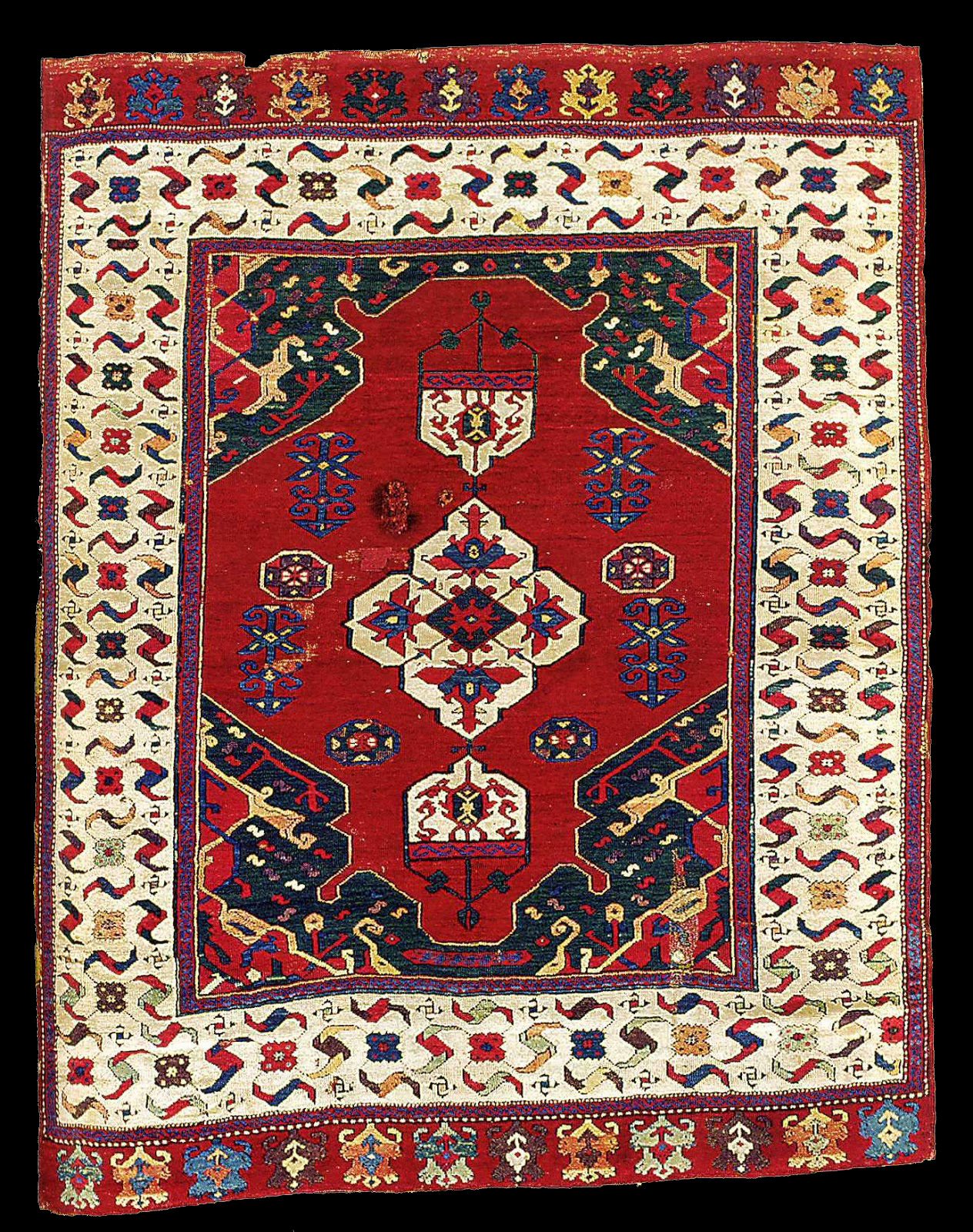Tabibnia Western Anatolian rug, Ottoman Empire, XVII century. sold
at Christies on 17 October 2002, for $120 165 (Hali 126-132)
A
WEST ANATOLIAN RUG
USHAK DISTRICT, 17TH CENTURY
Price
Realized Ј77,675 ($120,396)
Price includes buyer's premium
EstimateЈ40,000 - Ј60,000
($62,000 - $93,000)
Sale
Information
Christies Sale 6630
oriental rugs & carpets
17
October 2002
London, King Street
Lot Description
A WEST
ANATOLIAN RUG
Ushak district, 17th century
The shaded
tomato-red ground scattered with angular floral motifs and octagonal
panels around a central cusped quatrefoil medallion with palmettes,
large angular pendants above and below, the shaded sea-green spandrels
with interlaced angular vine forming red panels, in a broad ivory
swirling leaf and rosette border between minor linked S-motif stripes,
a band of polychrome palmettes and striped kilim strip at each end,
corroded black, areas of slight wear, a few small old repairs, damaged
kilims turned under, generally good pile
6ft.1in. x 4ft.10in.
(185cm. x 147cm.)
Lot Notes
One
other fragmentary rug is very close indeed to the present
remarkable example and must come from the same area and period of
production (Alexander, Christopher: A Foreshadowing of 21st century
Art, New York and Oxford, 1993, p.203). The basic design features of
that rug are identical, the only major design differences are in the
guard stripes and in the addition of the end panels on the present
rug. The Alexander rug has a golden orange border and originally had
an indigo medallion; apart from this the colours are again very
similar indeed. While some other rugs share individual features with
the present rug, such as the border and the pendants (see below), none
other has the same combination and aesthetic.
Christopher
Alexander in his discussion of the rug investigates the border at some
length. It is the border, drawn on white ground, of another
fragmentary rug in his collection (op.cit, p.249), which also shares
the guard stripes with the present rug; it is also on an orange ground
in a rug from Divrigi (Balpinar, Belkis and Hirsch, Udo: Carpets,
Vakiflar Museum Istanbul, Wesel, 1988, no.28, pp.88 and 233). It
appears in a slightly debased version as a field design on a 17th
century rug in the Museum of Applied Arts, Budapest, drawn on an
orange ground duller than that of the Alexander border (Batбri,
Ferenc: Ottoman Turkish Carpets, Budapest, 1994, no.23, p.118). It
also formed the main field design on ivory of a very large and
somewhat strange 16th or 17th century carpet which came up for sale at
Sotheby's (London, 20 April 1983, lot 129). Its descendant even makes
an appearance on a blue ground early 19th century Caucasian rug
(Kirchheim, E. Heinrich et al.: Orient Stars, A Carpet Collection,
Stuttgart and London, 1993, pl.17, p.51).
Both Alexander and
Batбri (Ferenc: "White Ground Carpets in Budapest", Oriental Carpet
and Textile Studies, II, London, 1986, pp.198 and 199) demonstrate its
relationship to court design of the period through the similarity of
the pattern to that of two different panels of tiles in the Rustam
Pasha mosque in Istanbul dating from 1565. It is however possibly a
considerably older design in origin, deriving from the same root that
also provided the well-known "bird" rugs and carpets of the 16th and
17th centuries. Whatever its origin, and in contrast to most of the
bird rugs, it is always, as here, very vibrantly coloured, each
flailing leaf made of three different blocks of strong colour.
While the basic design of the field is very similar to that of a
number of sixteenth century small medallion Ushak rugs, the one
feature which stands out as unusual is the pendants. These appear much
more closely than normal to represent a lamp hanging on three chains.
There is however one very finely woven 16th century small medallion
Ushak rug in a private collection which has the same form of central
medallion flanked by yellow pendants on the medallion of the same form
as those found here. Whether the design here is copied from the
medallion Ushak we cannot know. What is very clear however is the
ivory lamps; they are certainly symbolic of the luminescence of the
colouration throughout.


